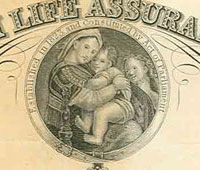From the 1600's through the late 1880's, the Parliament of England passed hundreds of laws which authorized the issuance of annuities to finance government operations and to provide retirement income to selected individuals. These laws were part of the body of general laws known as Acts of Parliament, which were declarations of the legislature, enforcing certain codes of conduct, or defining rights to be conferred upon, or withheld from, certain persons or classes of persons. Collectively, all the acts of parliament make up the statutes of the realm, or, in the widest sense, the written law of Great Britain from Anglo-Saxon times to the present day.
The Collection
1702 to 1714 - Reign of Queen Anne1714 to 1727 - Reign of King George I
1727 to 1760 - Reign of King George II
1760 to 1820 - Reign of King George III
1820 to 1830 - Reign of King George IV
1830 to 1837 - Reign of William IV
1837 to 1901 - Reign of Victoria
King's Warrant for Act of Parliament
In order to make the most current laws available to judges, barristers and other interested parties, sessional volumes (which contained all Acts passed in any one session of Parliament) were printed by the Crown Printer at the conclusion of that session, as a book. Entitled the "Acts of Parliament", these bound volumes are a vital resource for the historian.
The first official printed copies of the statutes were published in 1483, and contained all Acts passed during the first sitting of Parliament during the reign of Richard III. Sessional Volumes from before 1713 are, themselves, extremely scarce. In fact, only eight such volumes from the entire 17th century, are held at the Library of the House of Lords. Though Sessional Volumes achieved wider distribution after 1713, the Report of the Committee for the Promulgation of the Statutes (1796) tells us that no Sessional Volume printed and distributed before 1796 had a circulation larger than 1,100 or so, and these copies were distributed exclusively to Members of Parliament (Upper and Lower Houses), the judiciary and the great officers and offices of state. It is reasonable to conclude that the majority of these have not survived. Those that have are mostly now in libraries or museums.
Each Act in a Sessional Volume had its own title page (the reverse of which was blank) until 1798. Since 1794, each Act begins with a head ornament representing the Royal Anns and closes with a colophon that provides the place and date of publication, and the name of the Crown Printer. There is no title page, per se.
In 1797, Parliament passed a resolution increasing the circulation of the Sessional Volumes. Since then, the lesser judiciary, major public libraries, and a wide array of government officers at various levels of government have been on the distribution list. Still, for years thereafter, the circulation never exceeded 5,500 or so. The way the volumes were printed and distributed also changed at this time, with the Crown Printer printing each Act individually soon after it had received Royal Assent. The Acts did, nevertheless, have continuous pagination and signatures. Most were delivered, a few at a time, unbound, with the expectation that the recipients would bind them into volumes at the session's close. This practice remained until the 1880s, at which time the Stationery Office began to print all Acts (with separate pagination and signatures), as well as yearly Sessional Volumes, in larger quantities.
The holdings of the Annuity Museum contain many individual (unbound) Acts of Parliament relating to the issuance of annuities. The earliest document in this collection dates from 1702 and grants the government the right to raise money for continuing the war by selling annuities.


